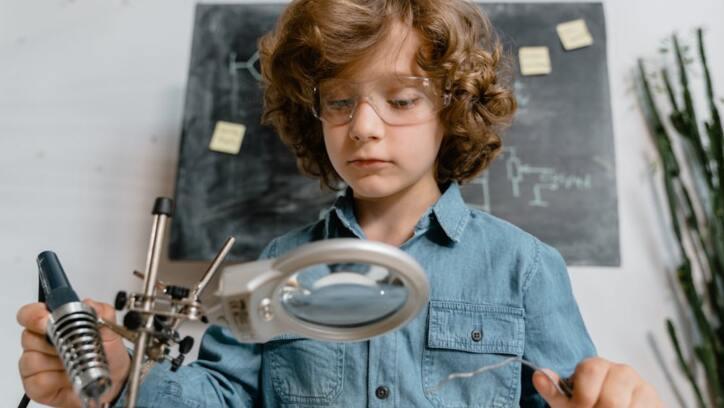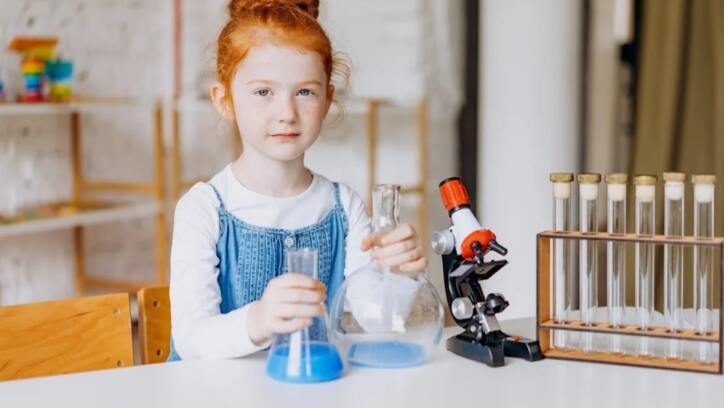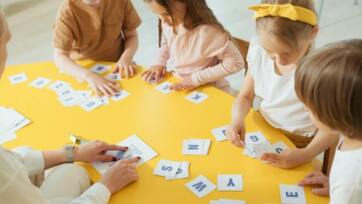Introduction
Science is an interesting academic subject that enables students to discover extraordinary things through curiosity. It provides fascinating experiences for students who want to study stars and small creatures on the ground. This article demonstrates basic science experiments combined with educational quiz questions, which motivate children of all ages to participate in interactive experiments.
The Power of Simple Science Experiments
Children should begin their science education by performing basic experiments that require classroom or domestic settings. Science experiments deliver two advantages: kids experience pleasure while understanding essential scientific knowledge, such as observation, cause-effect, reasoning, and critical thinking abilities. For example, combining baking soda with vinegar during a hands-on activity lets children witness chemical interaction to learn about acids and bases. The direct experience of these simple experiments lets students remember their school lessons more effectively.
Fun Quiz Question #1: What Happens When Mix Baking Soda and Vinegar?
An inquiry-based question about baking soda and vinegar combinations allows students to consider their predictions. When such an approach is used, the experiment becomes memorable, and children become more interested in learning. Following the experiment's completion, you should request an explanation from students regarding their observed reaction. The easy science demonstration provides children with their first exposure to chemistry principles.
Fun Quiz Question #2: Exploring the Science of Water
Scientists recognize water as a fundamental element on Earth, which demands fundamental knowledge of its properties for exploration. A simple science activity to observe the water surface tension involves putting water drops in dish soap or placing a paperclip on water. Observation of surface tension occurs when children place a paperclip precisely on water because the tension lifts the object. Children acquire an interest in water science through their introduction to concepts about the forces of cohesion and adhesion. The idea of density and freezing point can be easily investigated through experiments performed in the water medium.
Surface Tension stands as the response to Quiz Question #2.
The end of your water-based experiment presents an opportunity to query children about the floating behaviour of a paperclip on the water's surface. Such a question stimulates children's analytical capabilities regarding water-object interactions. Surface tension enables the paperclip to rest above the water surface even though it weighs more than water. This experiment provides a good opportunity for students to learn about invisible forces present in the world, which they can study through advanced experiments in the future.
Simple Electricity and Circuits
Electricity becomes interesting enough to explore through basic experiments that can take place at home. Students can construct foundation circuits using batteries, wires, and lightbulbs to observe electric current patterns. Elementary students gain knowledge about electrical conductors, insulation, and circuit requirements by participating in this activity. Such an experiment demonstrates to children exactly how daily electric devices, including light switches and remote controls, operate. Electricity flow represents a fundamental concept that students must learn within physics education and technical disciplines.
Fun Quiz Question #3: What Makes a Lightbulb Light Up?
After making their circuits, the students get a quiz asking them to explain what happens to a lightbulb when electrically connected to a battery. All the electrical current supplied by the battery travels through wires, enabling the filament inside the light bulb to function and create light. The understanding deepens by analyzing circuit interruptions and comparing open and closed circuits with an explanation of conductors and insulators in modern technology.
The Fascination of Magnetism
The magnetic phenomena fascinate children for an unlimited period. Children can develop knowledge about magnetic fields and learn about magnet poles by conducting a simple experiment with magnets. The experiment tests magnet attraction by allowing children to identify materials that respond to magnetism and materials that do not. This experiment shows children about magnetic forces while demonstrating how these forces operate without being visible yet possessing strong power. Children can observe the behaviour of multiple magnets as they experiment with their interactions to learn about practical magnet-based technologies, including motors and compasses.
Fun Quiz Question #4: The response to connecting two magnetic
Students often wonder what occurs when two magnets possess matching poles because this question provides an outstanding magnetism quiz challenge. Two magnets will push away from one another since the question has been answered correctly. Attracting forces develop between magnets that have opposite poles adjacent to each other. Understanding basic magnetism forms the foundation for investigating electromagnetic principles, which allow the development of magnetic applications such as Earth's fields because of their use in technology, including MRI machines.
The Science of Plants: Photosynthesis
Plants constitute a vital natural element scientists can investigate through basic experimental methods. Photosynthesis is an intriguing scientific phenomenon which enables green plants to transform solar energy into usable power. Children should experiment by putting a plant outside in sunlight and another in an enclosed dark space. By monitoring plant changes, students learn how vital sunlight becomes for their survival and growth throughout the observation period. The experiment teaches students about chlorophyll and plant life cycles through classroom discussion.
Fun Quiz Question #5: why do plants require sunlight?
Following a plant experiment, students should consider why plants require sunlight for their development. The scientific truth states that sunlight lets plants transform carbon dioxide into food through photosynthesis. Plant tissues employ light energy to turn water and carbon dioxide into glucose as their fuel source for growth and energy needs. Your question emphasizes how plants form an essential bond with their surroundings while showing the importance of photosynthesis as Earth's life-support system.
People discover the various marvels that exist within our solar system.
Children will never exhaust their curiosity when they explore the solar system. When kids make solar system models and use a flashlight to simulate the sun, they start to understand the planetary orbits around it. Children can perform shadow experiments demonstrating Earth rotation, leading to daily light and dark cycles. The educational activity teaches essential astronomy principles, including celestial body placement and movement patterns, helping youngsters develop a serious interest in spaceflight.
Fun Quiz Question #6: What Causes Day and Night?
People experience day and night on Earth due to Earth's rotational movement around its axis. Earth rotates while maintaining its axis alignment, which results in the succession of sunlight exposure across planet surfaces. Earth's daily axis rotation establishes the daily light and dark period. Students can use this query as an excellent starting point to learn about Earth's orbital mechanics and solar illumination effects while understanding their impact on regular life.
The Excitement of Chemical Reactions
Science experiments dependent on chemical reactions are essential to many intriguing experiments. When you blend water and cornstarch, you will make oobleck, which acts as a solid under force but turns into a liquid at rest. Through this experiment, children gain their first knowledge of non-Newtonian fluids and the unexpected behaviours materials show based on environmental conditions. When children observe oobleck under pressure, it exhibits solid characteristics yet allows drips to demonstrate the intricate chemical reactions around us.
Fun Quiz Question #7: What Happens When Mix Cornstarch and Water?
During oobleck experimentation conclude by asking young students this question: "What takes place during cornstarch and water combination?" Mixing cornstarch with water creates a non-Newtonian fluid substance that behaves as a solid under pressure but acts like a liquid when left without disturbances. This entry provides a wonderful first exposure to chemical reaction principles and materials science learning. Children understand the complex world better when they learn about substance behaviours thanks to these basic concepts.
A Study of Force-Motion Principles
The fundamental physics concepts involving force and motion utilize basic laboratory procedures well. Children can understand velocity concepts, gravity, and friction through a simple experiment involving a ball on a ramp. The students observe ball motion changes through modifications to ramp height or the use of various balls. Such exercises reveal physics fundamentals through teaching children about natural forces which dictate our environment.
Fun Quiz Question #8: What Happens When You Roll a Ball Down a Ramp?
When following a force and motion experiment, students should answer this quiz about rolling a ball down a ramp. The combination of gravitational pull downward, and a ramp's height controls a ball's rolling speed. The speed of the ball's movement is affected by the friction it generates with the surface.
Conclusion
The path of scientific exploration finds its most effective start through basic experimentation and entertaining quiz challenges. Science education becomes memorable and educational for children through their exploration of magnetism alongside solar system discoveries and chemistry principles. A solid science foundation forms when children participate in practical learning alongside intellectually challenging quiz questions, motivating them to undertake additional scientific investigations of the world. Future scientists will develop their curiosity when science becomes an active force anyone can understand.










